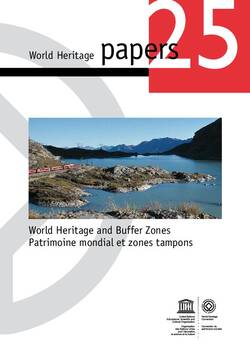International Expert meeting on World Heritage and buffer zones
Aim and Objectives
The main objectives of the meeting are to:
- Review the provisions on buffer zones and boundaries in the Operational Guidelines;
- Review case studies of World Heritage properties, natural, cultural and cultural landscape sites to be presented to the workshop;
- Review background papers by the World Heritage Centre and the Advisory Bodies as well as information analyzed through the Retrospective Inventory Project;
- Compile specific recommendations from the working groups at the Workshop and a draft decision for the 32nd Session of the World Heritage Committee.
The results of the meeting will be presented to the 32nd World Heritage Committee Session in 2008 in Quebec, Canada. A report documenting the proceedings of the meeting will be published.
Background and contents
A buffer zone serves to provide an additional layer of protection to a World Heritage property. The concept of a buffer zone was first included in the Operational Guidelines for the implementation of the World Heritage Convention in 1977. In the most current version of the Operational Guidelines of 2005 the inclusion of a buffer zone into a nomination of a site to the World Heritage List is strongly recommended but not mandatory.
Many World Heritage properties face problems that directly or indirectly derive from the situation of their buffer zone. New constructions within a buffer zone may have an impact on the World Heritage property and could threaten its Outstanding Universal Value; a different legal status of a buffer zone could also impact the conservation, the protection or management plan of a site.
This expert meeting will implement Decision 30 COM 9 by the 30th session of the World Heritage Committee. The discussion will focus on problems and best practices concerning buffer zones and issues related to the integrity of properties inscribed on the World Heritage List.
The outcome of the meeting, including proposals of modifications to the Operational Guidelines of the World Heritage Convention (Version 2005) regarding definition and management of buffer zones, as well as conditions of integrity, will be presented to the 32nd session of the Committee (Québec, July 2008). The discussion will be based on case studies (of natural sites, cultural sites, mixed sites, and cultural landscapes) as well as on the results of studies undertaken in the framework of the Retrospective Inventory, Periodic Reporting and State of conservation processes.
Experts and site managers from States Parties to the World Heritage Convention, representatives from the Advisory Bodies to the Convention IUCN, ICOMOS, ICCROM, representatives of related Conventions and programmes (RAMSAR, MAB) as well as representatives of UNESCO and the World Heritage Centre will participate in the meeting.
Languages
The working languages of the meeting are French and English. There will be an interpretation service in both languages.
Partners
The meeting is organized under the auspices of UNESCO by: The Swiss Federal Office for Culture, The Swiss Federal Office for Environment, The Israel National Commission for UNESCO.
Davos, Switzerland
Decisions (2)
The World Heritage Committee,
1. Having examined Document WHC-11/35.COM/7.1,
2. Recalling Decisions 30 COM 9, 32 COM 7.1, 33 COM 7C and 34 COM 19 adopted at its 30th (Vilnius, 2006), 32nd (Quebec City, 2008), 33rd (Seville, 2009) and 34th (Brasilia, 2010) sessions respectively, and the provisions for buffer zones established in the Operational Guidelines,
3. Notes the progress made with the wide range of issues relevant to World Heritage and buffer zones including the publication on "World Heritage and Buffer Zones" (World Heritage Papers 25), and considerations within discussions on "World Heritage and sustainable development";
4. Further notes that threats originating outside the World Heritage properties and beyond buffer zones may have adverse impacts on the Outstanding Universal Value of properties and therefore encourages States Parties, together with the World Heritage Centre and the Advisory Bodies, to take into account the recommendations of the «International Expert Meeting on Buffer zones» (Davos, Switzerland 2008) as provided in the detailed report of the meeting and its publication;
5. Also encourages States Parties to refine and put in place relevant legal tools or management plans concerning the conservation of properties and management of buffer zones.
Read more about the decisionThe World Heritage Committee,
1. Having examined Document WHC-08/32.COM/7.1,
2. Recalling Decision 30 COM 9, adopted at its 30th session (Vilnius, 2006) and thanking the States Parties of Israel and Switzerland for jointly hosting the International Expert Meeting on World Heritage and Buffer Zones (Davos, Switzerland, 11-14 March 2008) in cooperation with the World Heritage Centre;
3. Notes the detailed report provided by the expert meeting which reflects on a wide range of issues relevant to World Heritage and buffer zones and also notes the publication under preparation for the World Heritage paper series;
4. Requests the World Heritage Centre and the Advisory Bodies to use the terms "property" and "buffer zone" in all documents, and to stop using the term "core zone".
5. Also requests the World Heritage Centre and the Advisory Bodies to prepare draft revisions to the Operational Guidelines, taking account of the Committee's debate on the results of the International Expert Meeting on World Heritage and Buffer Zones by 1 December 2008, with particular emphasis on developing a lexicon of terms;
6. Further requests the World Heritage Centre to circulate these draft revisions to States Parties for comment, so that the proposed revisions can be submitted for consideration by the World Heritage Committee at its 33rd session in 2009.
Read more about the decision